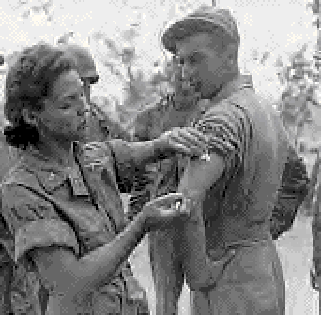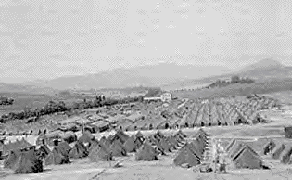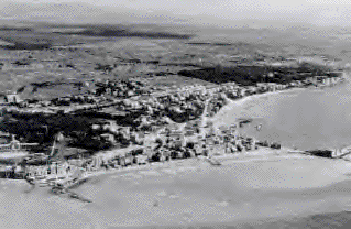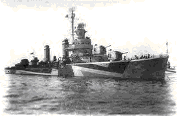www.DarbyRangers.Com | Follow Me
The 'Angels of Anzio'
 The Nurse Corps: Sicily to Anzio (1)
The Nurse Corps: Sicily to Anzio (1)The nurses' performance during the North African invasion taught the Army several lessons that it applied to the invasions of Sicily and southern Italy.
Commanding officers noticed that nurses acclimated quickly to difficult and dangerous conditions with a minimum of complaints. Their efficiency and professional accomplishments made them essential members of the field armies. The presence of nurses at the front improved the morale of all fighting men because soldiers realized that they would receive skilled care in the event they were wounded. Hospitalized men recovered sooner when nurses cared for them.
Troops in the field figured that "if the nurses can take it, then we can."
Anzio/Nettuno
To speed up the slow pace of the Allied northward advance through Italy against the fierce German defenses at Cassino and the Gustav Line, Allied strategists planned a landing behind the German lines. A projected 12 percent casualty rate was expected
On 22 January the British and American troops launched their unexpectedly successful surprise attack and landing on the Anzio beachhead. Because surprise was complete, the projected 12 percent casualty rate was held to less than 1 percent throughout the initial landing.
View of a General Hospital Algeria 1943 (US Army Photo)
 The Germans, however, quickly regrouped for a stubborn defense that pinned the Allied forces in the beachhead and Cisterna for four months and stalled hopes for a rapid advance. Within the congested invasion perimeter, casualties mounted as the Allies repulsed persistent Luftwaffe and ground attacks.
The Germans, however, quickly regrouped for a stubborn defense that pinned the Allied forces in the beachhead and Cisterna for four months and stalled hopes for a rapid advance. Within the congested invasion perimeter, casualties mounted as the Allies repulsed persistent Luftwaffe and ground attacks.The 33d Field Hospital and the 95th and 96th Evacuation Hospitals landed with the Anzio beachhead assault force and quickly set up operations. Approximately two hundred nurses were assigned to these units. On 24 January 1944, two days after the landing, the first bombs fell near the medical facilities. That night three British hospital ships, H.M.S. St. David, H.M.S. St. Andrew, and H.M.S. Leinster, were attacked by Luftwaffe aircraft while evacuating casualties from the beachhead.
As in the case of the sinking of the Hospital Ship Newfoundland, the ships were well lighted and clearly marked with the red cross. The St. David, with 226 medical staff and patients aboard, received a direct hit and sank.
The two Army nurses on board were among 130 survivors rescued by the damaged Leinster. One of these nurses, 2d Lt. Ruth Hindman, had survived the earlier bombing of the Newfoundland.
A military post operative hospital; 1944
(US Army Photo)
 Bombing of the 95th Evacuation Hospital
Bombing of the 95th Evacuation HospitalOn 7 February a German plane attempting to bomb the port at Anzio was intercepted by a British Spitfire. While trying to gain altitude, the German pilot jettisoned his antipersonnel bombs on the 95th Evacuation Hospital. The direct hit on the surgical section killed 26 staff and patients, including 3 nurses; 64 others were wounded. The day before, several news correspondents had decided among themselves that the constant shelling had rendered one nurse too nervous to carry on much longer. Yet after the bombing, this nurse calmly took charge, rallied the surviving staff (nurses and corpsmen), and guided their treatment of the wounded. The valiant efforts of the Medical Services saved many allied lives at Anzio.
Earlier Operations
US and British troops invaded Sicily on 9 July 1943, and nurses of the 10th Field Hospital and the 11th Evacuation Hospital arrived on the island three days later. There they were greeted by German Stuka dive bombers which forced them into slit trenches and foxholes during the first few days. Other nurses scheduled to support the invading US Seventh Army had to wait nine days for transport, which was in short supply during the first week of the invasion.
The intense heat on Sicily affected everyone, and the 128th Evacuation Hospital established at Cefalu (east of Palermo) saw increasing numbers of soldiers with malaria. Nurses lined the tents with mosquito netting in an attempt to control the spread of the disease through the hospital, but eventually medical personnel also succumbed. Despite the malaria epidemic, nurses at this hospital worked twelve-hour shifts.
Teams of specialists (doctors and nurses) handled a spectrum of wounds including head, chest, and orthopedic as well as shock cases. Patient turnover was high. The hospital would admit 300 patients in one 24-hour period and evacuate 200 to North Africa for further treatment. Most patients went by train to the coast where they were placed on hospital ships. Critically ill patients were evacuated by plane.
Lt. Gen. Mark W. Clark originally planned that nurses should land with the troops during the 8 September invasion of the Italian mainland and care for the men as they had done in North Africa. However, after the Allies decided to land at Salerno rather than Reggio, General Dwight D. Eisenhower, Commander in Chief, Allied Expeditionary Force, decided to postpone the nurses' arrival. The Salerno beachhead was small, and there were few exits off the beaches. Eisenhower and his advisers believed that the beachhead would be heavily defended and that the nurses should wait until the landing force was secure.
On the night of 13 September German planes bombed the British hospital ship H.M.S. Newfoundland while it was en route to Salerno carrying the nurses. Bands of green lights and brilliantly illuminated red crosses clearly identified the Newfoundland as a hospital ship. Before the ship sank, British vessels rescued all 103 nurses aboard and evacuated them to Bizerte, Tunisia. Four nurses suffered minor wounds for which the Army later awarded them the Purple Heart. The others boarded another ship and arrived at Salerno ten days later.
The winter rains, which usually arrive in southern Italy in November, came one month early in 1943, making it very difficult to maintain adequate medical facilities under canvas. Three days after the nurses arrived at Salerno a severe storm knocked down the tents of the 16th Evacuation Hospital, housing approximately 1,000 patients. Nurses evacuated the drenched patients to an abandoned tobacco warehouse without incident, preventing complications from exposure.
Continuous bad weather caused one of the most famous incidents in Nurse Corps history. On 8 November 1943, a C-54 ferrying thirteen flight nurses and thirteen medical technicians (corpsmen) of the 807th Medical Air Evacuation Transport Squadron from Sicily to Bari on the east coast of Italy ran into severe weather. The plane lost radio contact, the compass failed, and the pilot became disoriented in the storm. Icing finally forced the plane down in the Albanian mountains far behind German lines. Partisan guerrillas found the Americans and took them to a nearby farmhouse. That night the flight crew set fire to the plane to conceal traces of their presence in the area.
The partisans escorted the fugitives through the mountains on foot to safety behind Allied lines.
In bitterly cold weather and blinding snowstorms, the small band made a hazardous, two-month journey covering 800 miles. The escapees suffered from frostbite, dysentery, jaundice, and pneumonia, but all the nurses except three who were separated from the main body of the group arrived safely at Bari on 9 January.
The three missing nurses faced different hardships. A German unit trapped them for several months in the partisan town of Berat in the home of a partisan guerrilla. Dressed as Albanian civilians and supplied with Albanian identification cards, the nurses finally left Berat by car in March. They traveled far into the countryside, where partisans gave them donkeys to ride and escorted them across several mountain ranges. When they reached the coast, an Allied torpedo boat took them to Otranto, Italy.
With their arrival at Otranto on 21 March, the three nurses completed a five-month sojourn behind enemy lines. The courage and fortitude of the "Balkan Nurses" on their 800-mile hike behind enemy lines provided an example of the Army nurse's ability to withstand hardships "at the front."
 .
.The Anzio Nettuno Beachhead
(National Archives Photo: Public Domain)
ANZIO LANDING 22nd JANUARY...
A DATE TO REMEMBER
as the Italians see it...
(Each year) preparations are under way at Anzio/Nettuno for the ceremonies that record what took place a short distance south of Rome on 22nd January, 1944. On that day, thousands of British troops, supported by American units, landed along the coast at Anzio/Nettuno. Why did they come? What was their objective?
At the time of the landing the war had been in progress for four years (from September 1939). After many reverses in Europe, Africa and the Soviet Union, things were now moving in favor of the Allied armies. Preparations were under way for the D-Day landings. The Allied Command hoped to neutralize the German/Italian armies in Italy, so as to make the landings in Northern Europe less difficult.
The plan then was to land British troops - supported by the Americans and others - behind the German lines and move quickly to take Rome; but what was more important was to capture the mass of German troops. It was a plan that could shorten the war by months. But like any audacious plan it required (large numbers of) men able to carry it out. It is now clear that this was not the case at Anzio. Instead of moving quickly to capture Rome having gained the element of surprise, with no German/Italian forces to block the landing army, John Lucas, the US general put in charge of the operation, decided to wait on the beaches until he had more troops and supplies.
Fatal decision
It was to be a fatal decision. For within a short space of time the Germans moved troops and armor to surround the beachhead and confine the troops who had landed to this small area. So, with the sea at their backs and surrounded by German/Italian troops, the Allied soldiers "dug in" to defend their positions.
At one point the violent German/Italian attacks almost cut the small beachhead in two. But worse was to come. General Penney, the British commander, felt that what was of major importance was not now the capture of Rome, but to cut off and capture the German army operating south of Rome.
The idea was to move through Valmontone and to the north, then turn and cut off the German troops. It would have been a brilliant move. But it didn't happen, It didn't happen because Mark Clark, the US general now in charge, wanted to be "the first into Rome".
He got his way - and the German army escaped north, to prepare the Gothic Line. On their way they also carried out the shocking massacre of civilians at Marzabotto. These are some of the things some of us will remember on 22nd January, when we are in the cemetery at Anzio.
Could massacres have been avoided?
It is pertinent to ask. If the troops who landed in January had moved swiftly, as planned, to capture Rome, might we have avoided the massacre at the Ardeatine Caves, when more than 300 were murdered in March? We were part of a war to liberate Europe from dictatorship. To bring back to Europe the freedom destroyed by the Nazis in Germany and the Fascists in Italy. Winston Churchill warned of Europe "returning to the Dark Ages and barbarism"; he was right, of course.
Those who landed at Anzio/Nettuno on that 22nd January were playing their part to ensure that Italy - and Europe - were free once again. So when we remember those who died, we must also remember why.
by Harry Shindler (The Italy Star Association's representative in Italy)
First published in "The Informer" 1996 the magazine you need to understand Italy.
Men who Died in the Caves of Ardeatine, 1944
Thursday afternoon, March 23, 1944, a group of partisans attacked a column of 156 SS police on the Via Rasella in the center of German-occupied Rome. Immediately upon receiving the news, Hitler ordered that within twenty-four hours ten Italians must be exterminated for each German killed. 335 Italian men and boys from all walks of life were brutally murdered.
In 1966, author Robert Katz researched and published a book called 'Death in Rome', which reconstructed the events that led to this unforgettable event in history.
War Crimes against Albert Kesselring for the Ardeatine Massacre
* * *
Anzio Annie
Tucked Away in the Hills of Italy
was the Dangerous German Rail Gun
'ANZIO ANNIE'
(1) http://www.army.mil/cmh-pg/books/wwii/72-14/72-14.htm
